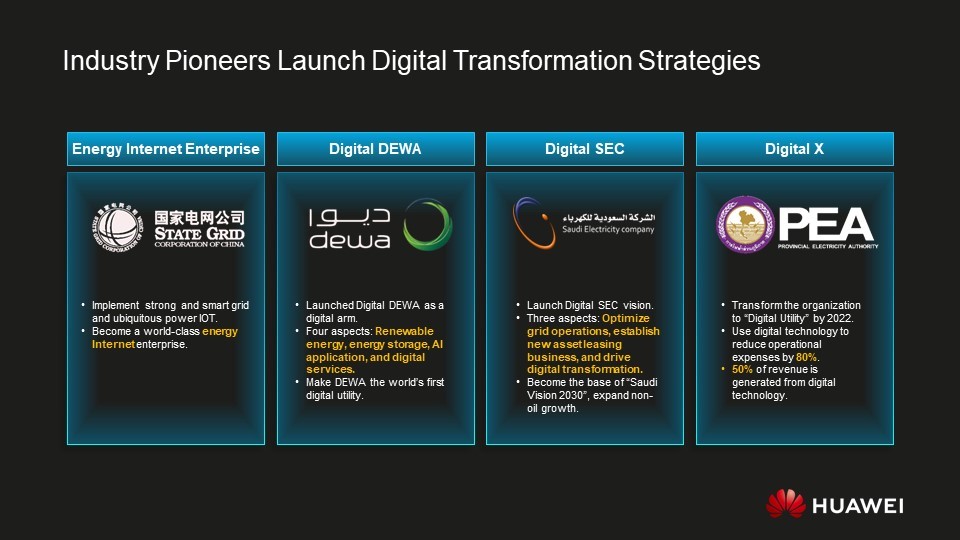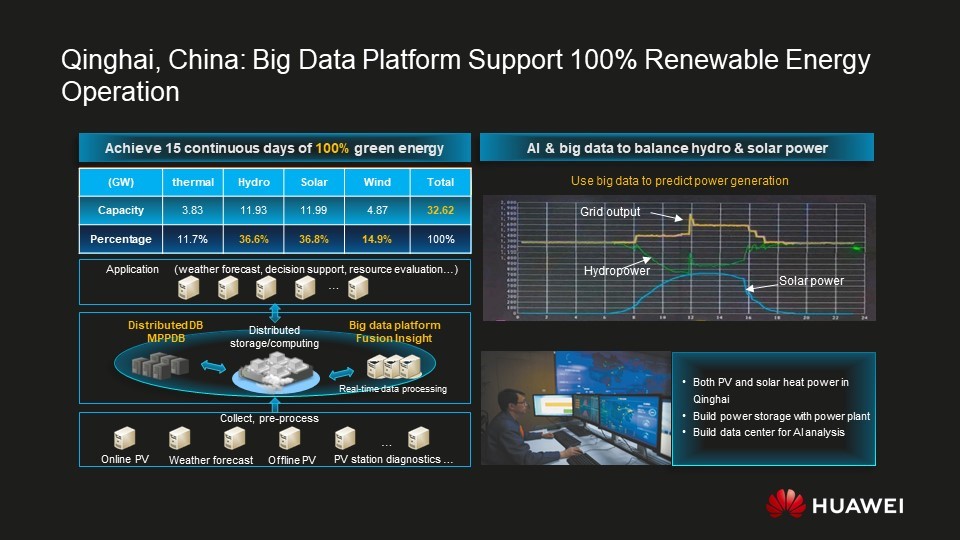This site uses cookies. By continuing to browse the site you are agreeing to our use of cookies. Read our privacy policy>
![]()
This site uses cookies. By continuing to browse the site you are agreeing to our use of cookies. Read our privacy policy>
![]()
Enterprise products, solutions & services
As we all know, the electric power industry is well-established and rather traditional in its outlook. However, it is being shaken up in a new era and facing huge challenges.
What are these trends and challenges being faced?
As more and more people become aware of global warming, governments are encouraging electric power companies to invest more in renewable energy. And in recent years, this trend toward renewables has been developing at pace. For example, in China, the government's target is to increase the ratio of renewable energy to more than 50% by 2030.
Electric Vehicles (EVs) are also gaining in popularity, with the industry now being actively supported by government policy. Third party forecasts predict that 50 million EVs will be in use in China within ten years.
Elsewhere, energy resources are unevenly distributed between different regions and different countries, making long-distance electricity transmission inevitable — it will be developed.
And natural disasters, from earthquakes and floods to — yes — COVID-19, are another factor affecting grid reliability.
So everyone working in this industry is now thinking hard about how to adapt to new trends and overcome pressing challenges, by making full use of technology. It is, then, with absolute certainty that we can say, ICT and digital transformation have an increasingly important role to play.
Over the past six months, due to the pandemic, demand for all natural resources has decreased, while reliance on global renewable energy generation has increased. Quite simply, renewable energy has been less impacted by COVID-19 because there is less human involvement in Photovoltaics (PV) or wind power generation , and therefore less worries regarding social distancing, remote working, and the like.
More and more electric power companies now say that digital transformation strategies are their first priority. Through transformation, companies are building unified digital platforms to manage their mass internal operations systems as well as using existing data and resources to develop more business. For example, in Saudi Arabia, the Saudi Electricity Company (SEC) is implementing its vision of improving operational efficiency through digital means and developing its asset-leasing business. Eventually, SEC wants to be the digital foundation of Saudi Arabia.

With the rapid development of distributed clean energy, grid architecture is changing. Traditionally, energy flow begins at a power plant and is then transmitted, transformed, and distributed to consumers. However, in the future, this model will be transformed. So, for example, while EVs will still be energy consumers, they can also store energy and send power back to the grid when the tariff is relatively high.
Indeed, the synergy of energy flows, information flows, and business flows will become more and more important.
And as the power grid becomes more complex, the ICT network and digital foundations must be more flexible. During the pandemic, to take a real-world example, the State Grid Corporation of China (SGCC) provided daily business recovery indexes through big data. This gave the government real-time visibility regarding employment rates of industries in different cities, allowing it to gauge the impact that was taking place.
Some power companies are also developing integrated energy services to, for instance, help big shopping malls and communities improve their energy efficiency.
Today, 5G is center stage across vertical sectors and electric power vendors, along with 5G vendors, are exploring what the technical possibilities are. For example, China Southern Grid conducted a field test, proving that 5G slicing can be securely deployed on grids. That means operational data, internal IT information, and public data can be isolated. Huawei believes that 5G will indeed be widely deployed on grids of the future.
Huawei is working with SGCC on a digital platform, an Internet of Things (IoT) platform, and a cloud platform. The State Grid of Henan — a provincial branch of SGCC — uses a unified platform to provide efficient services for both internal and external users. Before deploying this platform, it took the State Grid of Henan four hours to collect data and transfer it to databases. Today, it takes just 30 minutes.

We just mentioned that cloud and big data technology can improve both Operations and Maintenance (O&M) efficiency and the customer experience for power grids. Renewable energy generation can also benefit from these twin technologies in areas that have traditionally been of concern: namely, helping to predict output levels, and securing access to the power grid.
In the past, the State Grid of Qinghai wasted its renewably generated energy. To solve this issue, it deployed power storage within power plants themselves, and worked with Huawei to build a new energy data center featuring Artificial Intelligence (AI) and big data capabilities. Based on weather forecasting, we can now better predict renewable power output. And with multi-energy compensation, the total power output that accesses the grid will be more stable. Indeed, Qinghai Province set a record last year and maintained 100% green energy generation for 15 consecutive days.
Transmission lines play a key role in a power grid, which is why utility companies invest heavily in line O&M. But manual inspection is dangerous and highly inefficient. Based on a joint innovation with CSG , Huawei has built AI modules in cameras and drones. O&M teams can now monitor transmission lines remotely, detecting faults through cameras. And, using AI capabilities, the cameras only flag and send images or video clips that are related to faults. This saves bandwidth and time, significantly improving O&M efficiency. For example, the Shenzhen Power Supply Bureau has shortened inspection time from 20 days to just two hours, with the time to capture images reduced from hours to minutes, and image analysis accuracy exceeding 90%.
In China, national strategy predicts the number of EVs will reach 6.18 million in 2020. In 2030, this number will exceed 50 million, as we touched on at the very beginning. The ratio of EVs to charging piles will develop from 3:1 to 1:1, the number of charging piles will increase from 1.22 million to 3 million, and there will be 48,000 public charging stations. And it's the cloud that will enable unified deployment and remote management of millions of EVs and charging piles.
An AI data analytics platform will also be deployed in the management system to improve charging efficiency and better manage battery lifespan.
ICT infrastructure is the foundation of digital transformation. And 5G, AI, big data, and cloud will accelerate digital transformation.
As a leading ICT provider of 5G, AI and cloud, Huawei is supporting more than 190 electric power companies around the world, ten of which are among the industry's top 20. We are helping them all to build ICT infrastructure and achieve digital transformation. Huawei's aim is to become the best transformation partner in the digital age.